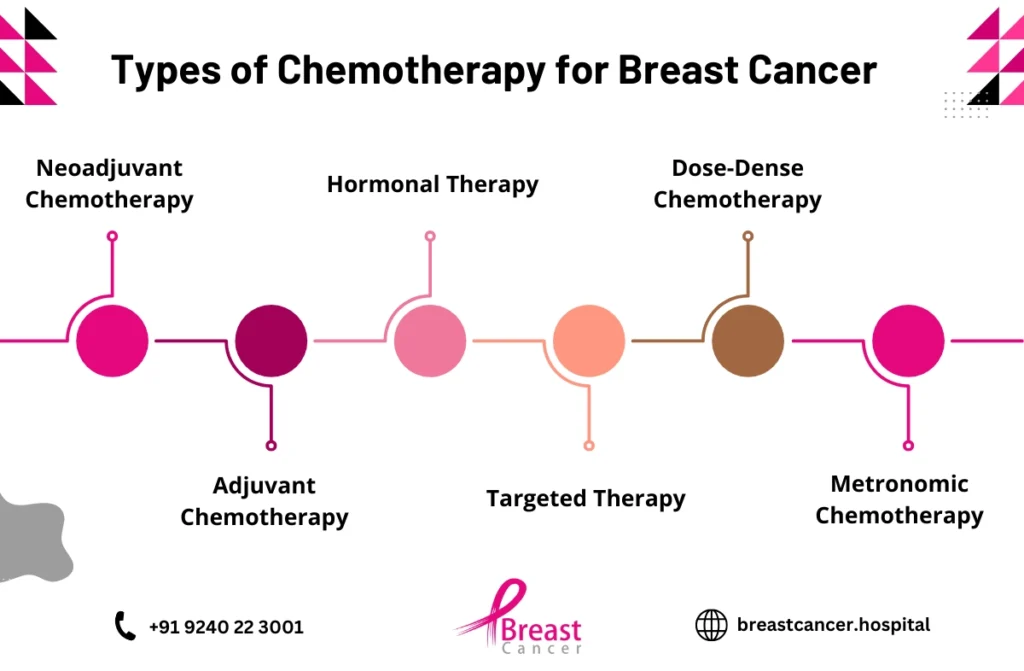“Chemo treatment for breast cancer” is a common approach to fighting breast cancer. It uses powerful drugs to target and kill cancer cells, and while it can be an effective form of treatment, it also has a range of effects on the body. In this post, we’ll explore what chemotherapy entails, discuss different types, potential side effects, and provide tips for managing the treatment process.

What is Chemo Treatment for Breast Cancer?
Chemo treatment for breast cancer involves the use of drugs to destroy cancer cells throughout the body. Chemotherapy can be given before surgery (neoadjuvant therapy) to shrink the tumor or after surgery (adjuvant therapy) to eliminate any remaining cancer cells. This treatment can also be used in advanced stages to control the spread of the disease.
When is Chemotherapy Used for Breast Cancer?
Chemotherapy is used at various stages of breast cancer treatment, depending on the type and stage of cancer. It can be employed before surgery (neoadjuvant chemotherapy) to shrink the tumor, after surgery (adjuvant chemotherapy) to reduce the risk of recurrence, or as the primary treatment for advanced or metastatic breast cancer.
- Early-Stage Breast Cancer (Stage 1 and 2): Chemotherapy may be used after surgery to kill any remaining cancer cells and prevent recurrence.
- Locally Advanced Breast Cancer (Stage 3): Chemotherapy helps shrink tumors to make them easier to remove surgically.
- Advanced or Metastatic Breast Cancer (Stage 4): Chemotherapy may be the primary treatment to control the growth and spread of the cancer.
Patients often ask, “Is chemotherapy painCan you live a normal life on chemotherapy?ful for breast cancer?” Chemotherapy is generally not painful itself, but the side effects like nausea, fatigue, and hair loss can be challenging. However, these side effects are temporary, and many patients recover after completing the treatment.
Types of Chemotherapy for Breast Cancer
Chemotherapy can be administered in different ways, depending on the specific case and stage of breast cancer:
- Intravenous (IV) Chemotherapy: This method delivers the drugs directly into the bloodstream, allowing them to travel through the body.
- Oral Chemotherapy for Breast Cancer Stage 1: For early stages, oral chemotherapy can sometimes be an option, providing a convenient alternative to IV infusions. It involves taking chemotherapy pills by mouth, allowing patients to manage some aspects of their treatment at home.
Is Chemotherapy Painful for Breast Cancer?
A common concern among patients is, “Is chemotherapy painful for breast cancer?” Chemotherapy itself is not typically painful, but side effects can cause discomfort. Patients may experience fatigue, nausea, and sensitivity in certain areas, which can be managed with proper care and medications.
Managing Pain and Discomfort
While chemotherapy infusions or oral pills are generally not painful, some side effects can cause physical discomfort:
- Nausea and Fatigue: Medications can help alleviate nausea, while a balanced diet and rest are essential for managing fatigue.
- Sensitive Skin: Skin may become more sensitive during chemotherapy, and gentle skincare routines can help.
- Peripheral Neuropathy: Some chemotherapy drugs can cause tingling or pain in the hands and feet, often managed with pain relievers or supplements.
While chemo treatment options for breast cancer may come with challenges, support from a healthcare team can make a big difference in managing any discomfort.
Chemotherapy as the Primary Treatment for Advanced Breast Cancer
In cases of advanced or metastatic breast cancer, chemotherapy often becomes the primary treatment. It is used to control the cancer, reduce symptoms, and prolong the patient’s life. Chemotherapy for breast cancer at this stage may involve multiple cycles of treatment over a period of months or years.
For advanced breast cancer, patients may undergo 12 cycles of chemotherapy for breast cancer, depending on their response to the treatment. Chemotherapy at this stage may be combined with targeted therapy, hormone therapy, or immunotherapy to improve outcomes.
Key Points about Chemotherapy for Advanced Breast Cancer:
- Chemotherapy is used to control growth and alleviate symptoms of advanced breast cancer.
- Multiple cycles (often 12) may be needed to manage the cancer.
- Chemotherapy can be combined with other therapies for better results.
If you are considering oral chemotherapy for breast cancer stage 1, you may be prescribed medications like capecitabine (Xeloda) as part of a treatment regimen to target and eliminate cancer cells effectively.
Long-Term Side Effects of Chemotherapy for Breast Cancer
“Long-term side effects of chemotherapy for breast cancer” vary from person to person. While chemotherapy effectively targets cancer cells, it can also affect healthy cells, leading to long-lasting impacts on the body.
Common Long-Term Side Effects
- Heart Health: Some chemotherapy drugs can affect heart function, especially in long-term use. Regular cardiovascular check-ups are advised.
- Bone Density: Chemotherapy can lead to bone density loss, increasing the risk of osteoporosis. Supplements and exercise are recommended to maintain bone health.
- Cognitive Changes: Some patients experience “chemo brain,” or cognitive difficulties such as memory loss and concentration issues. These symptoms often improve over time with mental exercises and self-care.
- Hormonal Changes: Chemotherapy can disrupt hormonal balance, especially in younger women, potentially affecting fertility and causing early menopause.
While these side effects may seem concerning, advancements in chemotherapy and personalized treatment plans have improved the ability to manage them, providing patients with support for both immediate and long-term health.
Chemotherapy Drugs Used for Breast Cancer
Chemotherapy drugs are carefully selected based on the type and stage of breast cancer. Common chemotherapy drugs used for breast cancer include:
- Cyclophosphamide (Cytoxan): Often used in combination with other drugs, cyclophosphamide works by interfering with the growth of cancer cells.
- Doxorubicin (Adriamycin): This drug is known for its effectiveness in treating breast cancer, especially in its early stages.
- Paclitaxel (Taxol) and Docetaxel (Taxotere): These drugs are used to stop cancer cells from dividing and are often used in combination with others.
- Fluorouracil (5-FU): This chemotherapy drug helps treat breast cancer by interfering with DNA synthesis and the growth of cancer cells.
- Capecitabine (Xeloda): An oral chemotherapy drug that can be used for metastatic breast cancer.
One common question that arises is “Is chemotherapy painful for breast cancer?” While the procedure itself isn’t painful, some patients experience discomfort from the side effects, which can vary in severity depending on the individual and the specific drugs used.
Chemotherapy Side Effects
While chemotherapy for breast cancer is effective, it comes with a range of side effects, which can vary from person to person. Some common side effects include:
- Nausea and vomiting
- Fatigue and weakness
- Hair loss
- Increased risk of infection
- Changes in appetite or taste
The long-term side effects of chemotherapy for breast cancer can include fatigue, nerve damage, and potential heart problems, especially with certain chemotherapy drugs. These side effects can be managed with supportive care and medication.
Conclusion
Chemo treatment options for breast cancer remains a vital approach for many patients. While it comes with challenges, understanding the process, managing side effects, and knowing what to expect can make it more manageable. With support from a medical team and loved ones, patients can navigate chemotherapy and emerge stronger. If you or a loved one is facing chemotherapy, reach out to healthcare providers, ask questions, and consider joining support groups for guidance and encouragement.




